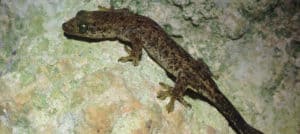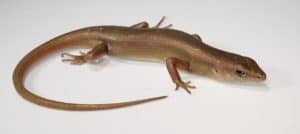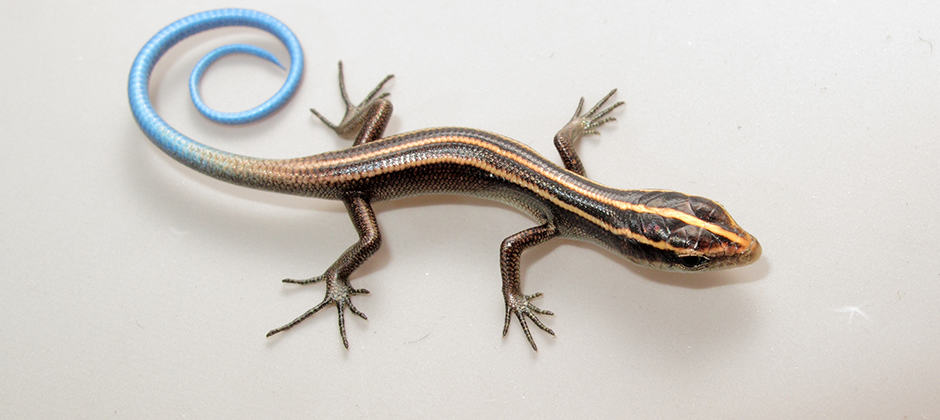Share this article
Introduced lizards squeeze out native reptiles on Saipan
Thousands of miles from the West Coast of the U.S. mainland lies the tiny island of Saipan, a tropical island rainforest often known solely for the World War II battle of its namesake. But some of the small wildlife in the small U.S. territory may now be facing a new invasive threat that has little to do with battleships. Introduced reptiles are squeezing native species out of much of their former habitat.
Invasive brown treesnakes (Boiga irregularis) have decimated native wildlife in nearby Guam, including reptiles and birds. Researchers wanted to know whether the snakes had also been introduced 120 miles away in Saipan, another island in the U.S. Northern Mariana Islands. If it hadn’t been, they wanted to determine the state of native reptiles and amphibians there in case the invasive snake somehow makes it to the island.
The researchers were also in search of the native Micronesia saw-tailed gecko (Perochirus ateles), which is listed as vulnerable by the International Union of Conservation of Nature. The lizard hadn’t been seen for some time on Saipan, and researchers suspected it might have become extirpated.

The saw-tailed gecko is considered vulnerable by the International Union for Conservation of Nature. ©U.S. Geological Survey, Danielle Bradke, Cherokee Nation Technologies
Eric Hileman, a research ecologist with the U.S. Geological Survey and the lead author of a study published recently in Global Ecology and Conservation, and his colleagues conducted surveys across the island for the lizards as well as for one introduced amphibian — the marine toad (Rhinella marina). Thankfully, they found saw-tailed geckos and no brown treesnakes. In fact, all lizards previously known to occur on the island, as well as the toad, turned up in surveys. Of these species, five are known to be native, while at least four are introduced. Researchers are unsure whether another four lizard species found on the island are introduced or native.
While surveys turned up all of the known lizards on the island, species distribution models showed that native saw-tailed geckos and Pacific bluetail skinks (Emoia caeruleocauda) were restricted mostly to a high elevation area lacking human development. However, a number of introduced species were found widely across Saipan.

Curious skinks are aggressive exotic lizards that prey on other lizards. ©U.S. Geological Survey, Björn Lardner
“It is clear that introduced species are swamping out native ones in some areas,” Hileman said.
The most aggressive of these outsiders is the curious skink (Carlia ailanpalai), a relatively large lizard whose native range is in Papua New Guinea. These ground skinks are also found widely across Guam and some of the other Northern Mariana Islands besides Saipan. Curious skinks, generalists that sometimes prey on other lizard species, were the only reptile found in many parts of Saipan, and they seem to do well in developed areas.
“It’s an excellent predator, and the fact that it occurs island-wide doesn’t bode well for some native lizard species,” Hileman said.
At the same time, control efforts on the Mariana Islands are focused on brown treesnakes and invasive rats (Rattus norvegicus), which both present more dire threats to native wildlife than curious skinks, Hileman said.
The good news is that the high elevation areas where the saw-tailed geckos and bluetail skinks are found are fairly large, he said.
“If that habitat can be ensured, then they should probably persist,” Hileman said, adding that the first priority to conserving these species would be to ensure this core area is protected and that it remains well connected. “Saipan still has this foothold where several endemic species are persisting, and we’d like to keep it that way.”
Reptiles represent important parts of the native ecosystem, he said. “There are instances where a species is lost and it has cascading effects that as researchers we didn’t expect,” Hileman said. “I think of it as a one-of-a-kind painting — once it’s gone, it’s gone.”
Header Image: Native Pacific bluetail skinks were pushed out of much of the habitat on Saipan by introduced species of reptiles. ©U.S. Geological Survey, Björn Lardner








